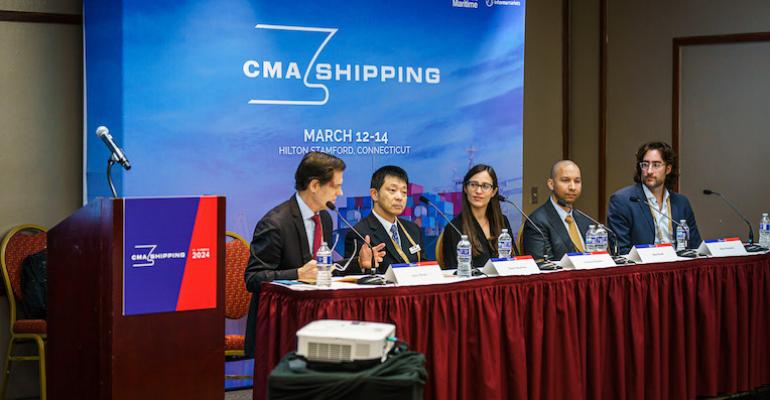CMA Shipping panel moderator James Rhodes, Chairman and CEO Magnuss, providers of a retractable sail system, and an Executive Committee member of the International Wind Ship Association (IWSA), commenting on the outlook for sails on vessels, said: “There has never been so much receptivity…there has never been a better time.”
He explained that the IWSA, starting out in 2012, now boasts a membership of 140 consisting of shipowners and technology providers. He emphasized that “the technology of sails is old, but the application is being driven by a confluence of environmental imperatives, regulations, customer interest, and the delivery of real savings.”
Emerging from the discussion was a synthesis of economics and technology. Panelist Nikos Petrakakos, Senior Advisor - Green Transition Initiatives at investment manager Tufton, which has recently launched a roughly $500 million investment vehicle for green shipping, noting that with expensive alternative fuels, “Shipowners are just doing everything they can to minimize fuel consumption.”
In his remarks, he explained that: “Wind propulsion might not seem that competitive now in terms of return on investment, but once you include carbon tax and the price of the new fuels, it suddenly becomes much more efficient,” adding that: “We are actively looking at wind propulsion.”
Tufton has installed a Fletner rotor system on a Kamsarmax bulk carrier on a lengthy charter to Cargill. From Tufton’s point of view, “working in partnership” with charterers, and said that longer term vessel employment, building on the model of infrastructure investment, was “more conducive to having discussions around wind.” When vessels are employed in spot markets, “some charterers may not want to pay extra where sails are deployed,” he added.
He also said that relationships are important, because installations “might not work perfectly on day one,” and that sharing of data on fuel consumption was a critical component of successful deals.
Masao Fukushima, a top executive in the wind propulsion department at shipowner Mitsui OSK Lines (MOL), talked about its efforts installing wind propulsion on multiple owned vessels.
MOL, which has a joint venture with the Oshima shipyard, hopes to provide its Wind Challenger hard-sail technology to others in the Japanese marketplace. Presently, the system has been installed aboard a 100,000 tonne bulker trading in the Pacific, with other installations pending in the drybulk and container sectors.
He explained that the hard-sail concept worked best with bulkers and tankers with lower profiles, and that kite-sail approaches worked best for containerships and vehicle carriers, with higher centers of gravity. “Weight of sails is also a consideration,” he explained, adding that MOL was asking suppliers to think about reducing the weight in their designs.
Multiple speakers, including Fukushima, highlighted that vessel stability needs to be considered. Rene Powell, Head of North American Business Development at Bureau Veritas emphasized that rules for classification of wind-powered vessels are continuing to evolve, and that each installation must be looked at one a case-by-case basis. He emphasized that safety is paramount, and that “Not all the systems work the same.
Panel member Cristina Aleixendri, Co-founder of bound4blue, developing a “suction sail” mentioned that her company’s installations aboard five vessels was benefiting from financial support from the European Union Innovation Fund. Similarly, MOL’s Fukushima also pointing to government grants as a funding source during projects’ development phases.
Aleixandri, affirmed the view that the economics of sails would improve dramatically improve, as carbon tax schemes continue to kick in, and mentioned that Poseidon Principles member banks are looking closely at developments in the wind sector.
Copyright © 2024. All rights reserved. Seatrade, a trading name of Informa Markets (UK) Limited.
Add Seatrade Maritime News to your Google News feed.  |

